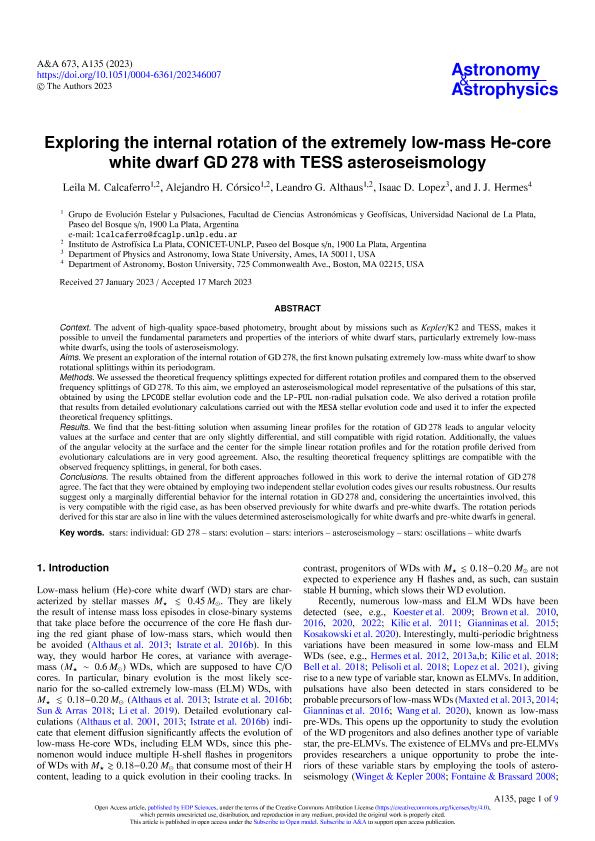Mostrar el registro sencillo del ítem
dc.contributor.author
Calcaferro, Leila Magdalena

dc.contributor.author
Corsico, Alejandro Hugo

dc.contributor.author
Althaus, Leandro Gabriel

dc.contributor.author
Lopez, Isaac D
dc.contributor.author
Hermes, J. J.

dc.date.available
2024-04-11T15:10:16Z
dc.date.issued
2023-05
dc.identifier.citation
Calcaferro, Leila Magdalena; Corsico, Alejandro Hugo; Althaus, Leandro Gabriel; Lopez, Isaac D; Hermes, J. J.; Exploring the internal rotation of the extremely low-mass He-core white dwarf GD 278 with TESS asteroseismology; EDP Sciences; Astronomy and Astrophysics; 673; A135; 5-2023; 1-9
dc.identifier.issn
0004-6361
dc.identifier.uri
http://hdl.handle.net/11336/232746
dc.description.abstract
Context. The advent of high-quality space-based photometry, brought about by missions such as Kepler/K2 and TESS, makes it possible to unveil the fundamental parameters and properties of the interiors of white dwarf stars, particularly extremely low-mass white dwarfs, using the tools of asteroseismology. Aims. We present an exploration of the internal rotation of GD 278, the first known pulsating extremely low-mass white dwarf to show rotational splittings within its periodogram. Methods. We assessed the theoretical frequency splittings expected for different rotation profiles and compared them to the observed frequency splittings of GD 278. To this aim, we employed an asteroseismological model representative of the pulsations of this star, obtained by using the LPCODE stellar evolution code and the LP-PUL non-radial pulsation code. We also derived a rotation profile that results from detailed evolutionary calculations carried out with the MESA stellar evolution code and used it to infer the expected theoretical frequency splittings. Results. We find that the best-fitting solution when assuming linear profiles for the rotation of GD 278 leads to angular velocity values at the surface and center that are only slightly differential, and still compatible with rigid rotation. Additionally, the values of the angular velocity at the surface and the center for the simple linear rotation profiles and for the rotation profile derived from evolutionary calculations are in very good agreement. Also, the resulting theoretical frequency splittings are compatible with the observed frequency splittings, in general, for both cases. Conclusions. The results obtained from the different approaches followed in this work to derive the internal rotation of GD 278agree. The fact that they were obtained by employing two independent stellar evolution codes gives our results robustness. Our results suggest only a marginally differential behavior for the internal rotation in GD 278 and, considering the uncertainties involved, this is very compatible with the rigid case, as has been observed previously for white dwarfs and pre-white dwarfs. The rotation periods derived for this star are also in line with the values determined asteroseismologically for white dwarfs and pre-white dwarfs in general.
dc.format
application/pdf
dc.language.iso
eng
dc.publisher
EDP Sciences

dc.rights
info:eu-repo/semantics/openAccess
dc.rights.uri
https://creativecommons.org/licenses/by-nc-sa/2.5/ar/
dc.subject
STARS: INDIVIDUAL: GD 278
dc.subject
STARS: EVOLUTION
dc.subject
STARS: INTERIORS
dc.subject
ASTEROSEISMOLOGY
dc.subject
STARS: OSCILLATIONS
dc.subject
WHITE DWARFS
dc.subject.classification
Astronomía

dc.subject.classification
Ciencias Físicas

dc.subject.classification
CIENCIAS NATURALES Y EXACTAS

dc.title
Exploring the internal rotation of the extremely low-mass He-core white dwarf GD 278 with TESS asteroseismology
dc.type
info:eu-repo/semantics/article
dc.type
info:ar-repo/semantics/artículo
dc.type
info:eu-repo/semantics/publishedVersion
dc.date.updated
2024-02-22T14:10:16Z
dc.journal.volume
673
dc.journal.number
A135
dc.journal.pagination
1-9
dc.journal.pais
Francia

dc.journal.ciudad
Paris
dc.description.fil
Fil: Calcaferro, Leila Magdalena. Universidad Nacional de La Plata. Facultad de Ciencias Astronómicas y Geofísicas; Argentina. Consejo Nacional de Investigaciones Científicas y Técnicas. Centro Científico Tecnológico Conicet - La Plata. Instituto de Astrofísica La Plata. Universidad Nacional de La Plata. Facultad de Ciencias Astronómicas y Geofísicas. Instituto de Astrofísica La Plata; Argentina
dc.description.fil
Fil: Corsico, Alejandro Hugo. Universidad Nacional de La Plata. Facultad de Ciencias Astronómicas y Geofísicas; Argentina. Consejo Nacional de Investigaciones Científicas y Técnicas. Centro Científico Tecnológico Conicet - La Plata. Instituto de Astrofísica La Plata. Universidad Nacional de La Plata. Facultad de Ciencias Astronómicas y Geofísicas. Instituto de Astrofísica La Plata; Argentina
dc.description.fil
Fil: Althaus, Leandro Gabriel. Consejo Nacional de Investigaciones Científicas y Técnicas. Centro Científico Tecnológico Conicet - La Plata. Instituto de Astrofísica La Plata. Universidad Nacional de La Plata. Facultad de Ciencias Astronómicas y Geofísicas. Instituto de Astrofísica La Plata; Argentina. Universidad Nacional de La Plata. Facultad de Ciencias Astronómicas y Geofísicas; Argentina
dc.description.fil
Fil: Lopez, Isaac D. Iowa State University,; Estados Unidos
dc.description.fil
Fil: Hermes, J. J.. University Of Boston. Departament Astronomy; Estados Unidos
dc.journal.title
Astronomy and Astrophysics

dc.relation.alternativeid
info:eu-repo/semantics/altIdentifier/url/https://www.aanda.org/10.1051/0004-6361/202346007
dc.relation.alternativeid
info:eu-repo/semantics/altIdentifier/doi/https://doi.org/10.1051/0004-6361/202346007
Archivos asociados
